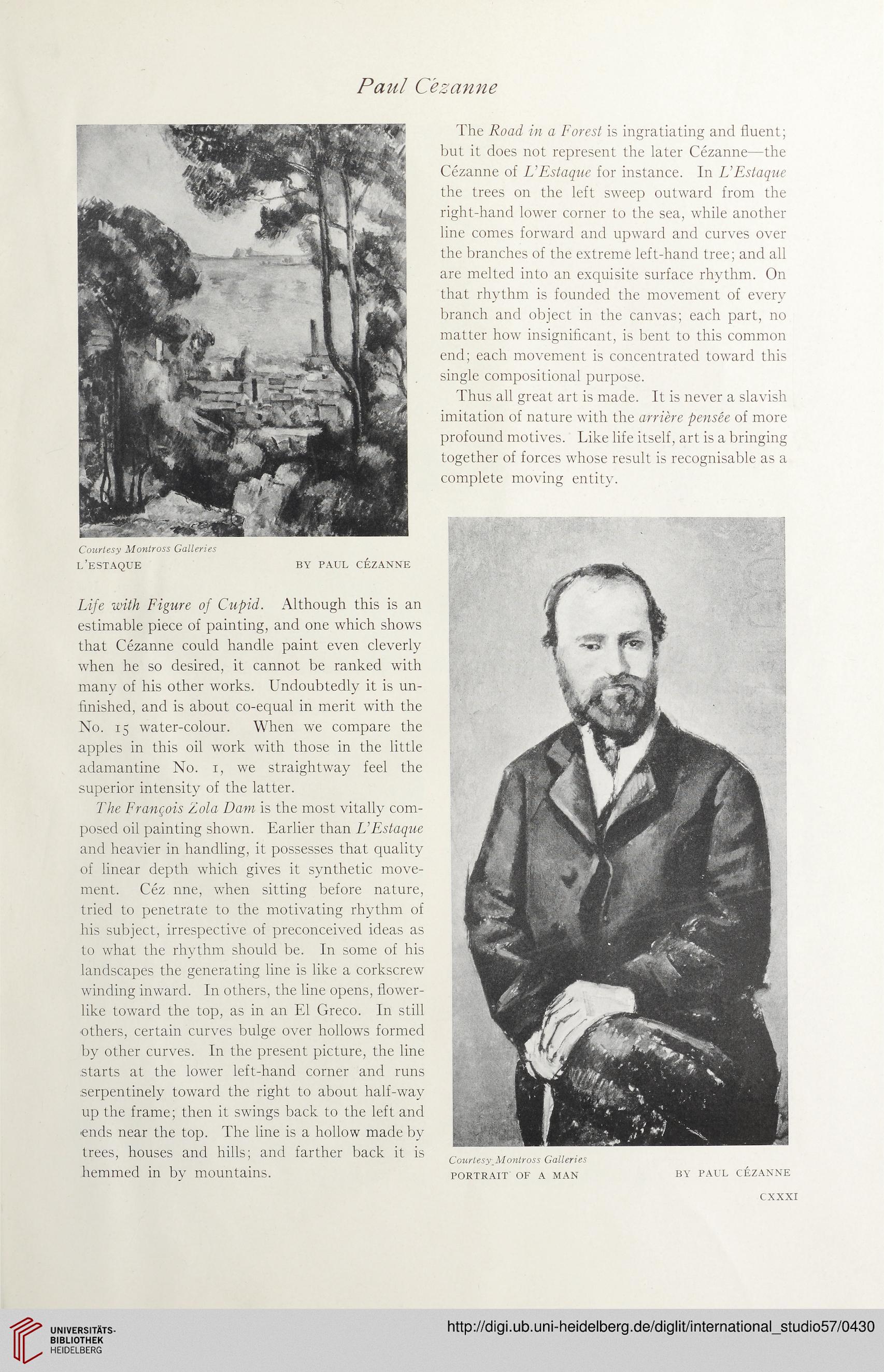Paul Cezanne
Courtesy Montross Galleries
L’ESTAQUE BY PAUL CEZANNE
Life with Figure of Cupid. Although this is an
estimable piece of painting, and one which shows
that Cezanne could handle paint even cleverly
when he so desired, it cannot be ranked with
many of his other works. Undoubtedly it is un-
finished, and is about co-equal in merit with the
No. 15 water-colour. When we compare the
apples in this oil work with those in the little
adamantine No. 1, we straightway feel the
superior intensity of the latter.
The Francois Zola Dam is the most vitally com-
posed oil painting shown. Earlier than VEstaque
and heavier in handling, it possesses that quality
of linear depth which gives it synthetic move-
ment. Cez nne, when sitting before nature,
tried to penetrate to the motivating rhythm of
his subject, irrespective of preconceived ideas as
to what the rhythm should be. In some of his
landscapes the generating line is like a corkscrew
winding inward. In others, the line opens, flower-
like toward the top, as in an El Greco. In still
others, certain curves bulge over hollows formed
by other curves. In the present picture, the line
starts at the lower left-hand corner and runs
serpentinely toward the right to about half-way
up the frame; then it swings back to the left and
•ends near the top. The line is a hollow made by
trees, houses and hills; and farther back it is
hemmed in by mountains.
The Road in a Forest is ingratiating and fluent;
but it does not represent the later Cezanne—the
Cezanne of DEstaque for instance. In L’Estaque
the trees on the left sweep outward from the
right-hand lower corner to the sea, while another
line comes forward and upward and curves over
the branches of the extreme left-hand tree; and all
are melted into an exquisite surface rhythm. On
that rhythm is founded the movement of every
branch and object in the canvas; each part, no
matter how insignificant, is bent to this common
end; each movement is concentrated toward this
single compositional purpose.
Thus all great art is made. It is never a slavish
imitation of nature with the arriere pensee of more
profound motives. Like life itself, art is a bringing
together of forces whose result is recognisable as a
complete moving entity.
CourlesyMontross Galleries
PORTRAIT OF A MAN BY PAUL CEZANNE
CXXXI
Courtesy Montross Galleries
L’ESTAQUE BY PAUL CEZANNE
Life with Figure of Cupid. Although this is an
estimable piece of painting, and one which shows
that Cezanne could handle paint even cleverly
when he so desired, it cannot be ranked with
many of his other works. Undoubtedly it is un-
finished, and is about co-equal in merit with the
No. 15 water-colour. When we compare the
apples in this oil work with those in the little
adamantine No. 1, we straightway feel the
superior intensity of the latter.
The Francois Zola Dam is the most vitally com-
posed oil painting shown. Earlier than VEstaque
and heavier in handling, it possesses that quality
of linear depth which gives it synthetic move-
ment. Cez nne, when sitting before nature,
tried to penetrate to the motivating rhythm of
his subject, irrespective of preconceived ideas as
to what the rhythm should be. In some of his
landscapes the generating line is like a corkscrew
winding inward. In others, the line opens, flower-
like toward the top, as in an El Greco. In still
others, certain curves bulge over hollows formed
by other curves. In the present picture, the line
starts at the lower left-hand corner and runs
serpentinely toward the right to about half-way
up the frame; then it swings back to the left and
•ends near the top. The line is a hollow made by
trees, houses and hills; and farther back it is
hemmed in by mountains.
The Road in a Forest is ingratiating and fluent;
but it does not represent the later Cezanne—the
Cezanne of DEstaque for instance. In L’Estaque
the trees on the left sweep outward from the
right-hand lower corner to the sea, while another
line comes forward and upward and curves over
the branches of the extreme left-hand tree; and all
are melted into an exquisite surface rhythm. On
that rhythm is founded the movement of every
branch and object in the canvas; each part, no
matter how insignificant, is bent to this common
end; each movement is concentrated toward this
single compositional purpose.
Thus all great art is made. It is never a slavish
imitation of nature with the arriere pensee of more
profound motives. Like life itself, art is a bringing
together of forces whose result is recognisable as a
complete moving entity.
CourlesyMontross Galleries
PORTRAIT OF A MAN BY PAUL CEZANNE
CXXXI




